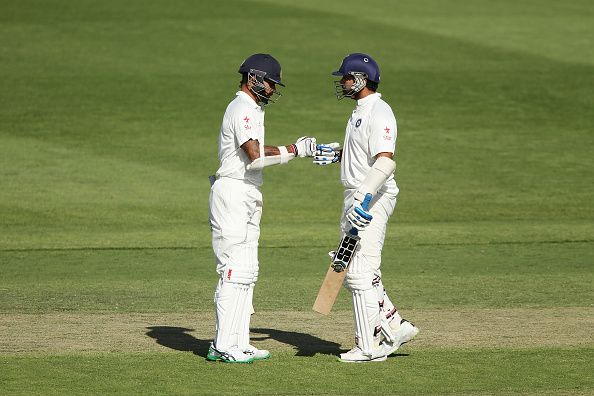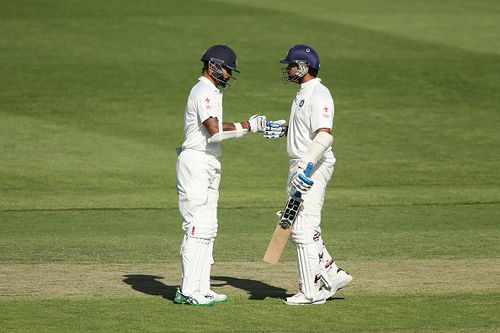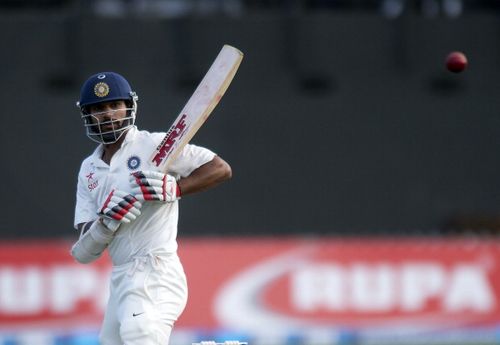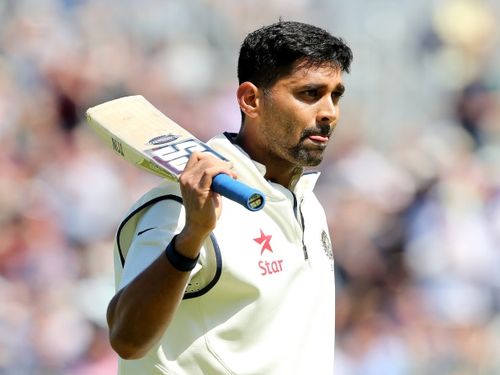
India’s overseas chronicles: Valiant Vijay and Disappointing Dhawan

It is Johannesburg, year 2013, and a colossus by the name of Sachin Tendulkar has just retired. If the ODI series is anything to go by, there are some serious questions that Indian batsmen need to answer. Captain MS Dhoni wins the toss and elects to bat first on a good wicket.
As Murali Vijay and Shikhar Dhawan walk out to bat, marking his run up is the world’s best Test bowler in the form of Dale Steyn. It’s not just the fiery pace one has to deal with but also the numbers, which are heavily stacked against the two: it’s been two-and-a-half years since an opening stand of 50-plus has been put up. In the previous 29 innings played in that country, only two century-run partnerships have been recorded by the openers, and none of those openers are in the national reckoning any more.
But Vijay and Dhawan are unperturbed. Lately, they have scored well together and are confident of the rapport they share.
The first ball is a wonderful outswinger, and Vijay watches it till the last minute. The second delivery nearly gets him out as he pokes tentatively at another brute of an outswinger. There’s a buzz around the ground, as everyone knows it’s only a matter of time. Vijay isn’t good at leaving the ball outside off-stump.
He leaves one and defends the next. Then the fifth delivery produces a gem of a shot: full in length, the ball drifts slightly towards middle and leg, and Vijay punches it down for four, easing it through the gap between the bowler and mid-on.
A few quiet overs later, Dhawan whips one off his pads for four. Then, he hooks one awkwardly for a boundary behind square. The single digit score has been crossed; Indian openers have halted at it 10 times since 1992-93. Not failing again must be such a relief. And almost immediately, a second short ball does the trick, inducing Dhawan into a pull. Imran Tahir latches on to one at fine-leg. Dhawan probably thought it’s the Kotla, but the Wanderers pitch is quicker.
The short-ball test has begun. The score is 13/1. At 24/1, Vijay gets a reprieve, dropped at short leg; however, he doesn’t make the most of it. A couple of run-less overs later, he drives at a ball outside off, no feet movement, and he is gone. The score reads 24/2, Vijay gone for 6, Dhawan gone for 13. Old habits die hard.
Baptism by fire
When the Indian team left the shores last year for what would be four sojourns across three continents, there was a definite air of expectancy surrounding the players. It would be the first time since 1996 that the names of Tendulkar, Rahul Dravid, Sourav Ganguly and VVS Laxman would be missing from the team sheet.
After the travails of England and Australia in 2011, one almost wanted the young lot to be baptised by fire. After all, none expected the likes of Steyn and Mitchell Johnson to bowl under-arm deliveries to the batsmen. There would be lots of chin music, and there would be lots of hopping around; however, at the end of it, India would rightfully recognize its gems. South Africa, New Zealand, England, followed by Australia – these were testing times, just like those that ended up producing India’s greatest ever middle-order.
What happened, though, evoked mixed responses. The string of losses ceased to stop, at times with the team almost playing into the hands of the opposition. There were the odd bright moments in the form of a fight at Johannesburg and Adelaide and a historic win at Lord’s. But that was about it. If in the 12 Tests played between Johannesburg and Brisbane, the average runs scored by an Indian batsman remains under 30 and each wicket comes at over 45 runs, there’s little about which one can eulogize.
Everyone knew that in the absence of a strong, experienced bowling unit, the batting had to come good. Only 10 centuries were scored though, with the highest being 153. Nearly 80 percent of the total runs accumulated were off the blades of three players, despite the fact that 18 others also played in that period. But the most alarming fact of the story was that an Indian opener was getting starts but not capitalizing on them each time.
Dhawan’s misfiring

Shikhar Dhawan is a proud man. Not only does he take immense pride in his game, he twirls his moustache, slaps his thighs like a wrestler after taking a catch and doesn’t back down from a word or two on the field. He is the mustachioed muscle man of Indian cricket, one who is giving his team a lot of headaches.
After getting out in the first innings at Johannesburg while attempting a pull, Dhawan notched up scores of 15, 29, 19 and 0 in his next four innings. Barring the three-ball duck against New Zealand in Auckland, he was at the crease for more than three-and-a-half hours to score a combined total of 63 runs. One could sense that he was trying really hard, but there was an odd similarity in the style of his dismissals. All the hard work wasn’t paying dividends.
At Johannesburg in the second innings, he went at a delivery outside off with hard hands; in Durban, he did something similar in the first innings and was dismissed by a beauty of a catch by Faf du Plessis in the second. He was getting the starts, but the big, solid knocks were missing.
After getting caught at slip for zero in Auckland, Dhawan came back with a 115 in the second innings; it was a knock that was laborious by his standards. He not only saw off the new ball but also batted for more than five hours before falling to a bouncer, leaving India agonisingly close to a win. There was a brisker 98 that followed in the next Test at Wellington. People felt that Dhawan had returned to form. But in the second innings he fell for two, making a quick return to the usual.
Following Wellington, Dhawan has scored just 289 runs from 11 innings. And apart from the 81 that he scored in Brisbane under a cloud of ‘unrest’, he has failed to cross 50 even once. He averages 26.27 and has batted for less than 80 overs in total.
In England, he was dropped from the XI after an abysmal outing in the first three games; in Australia, he hasn’t been able to contribute substantially. Dismissed 10 times between 0 and 40 in England and Australia alone, he has been mostly caught behind or at slips.
Is his technique faulty or his temperament? Usually, players overcome their technical disability with mental discipline, something Dhawan has failed to do time and again. He has gone for pulls from awkward positions and has played around with the ball outside off, at times giving the impression that he is confused about what to do. His feet movement has been indecisive, and determination to hang around absent.
Maybe it is time to look beyond Dhawan for Test matches. And a decision should be made irrespective of the quadruples Dhawan might score on Indian batting tracks. A wise option would be to groom KL Rahul as a permanent opener, opening up a middle order slot for the likes of Manoj Tiwary and Ambati Rayadu.
Vijay, you beauty!

Dhawan’s partner, Vijay, took off on a different plane altogether after his dismissal at Johannesburg. He has by far been India’s most consistent and dependable batsman in the last 13 months. Unlike his fellow opener, Vijay improved his game with a very vital weapon – the leave outside off.
This new facet of his game has ensured his survival over long periods of time. Among regular batsmen, he has one of the lowest strike-rates in this period, but has faced the highest number of deliveries, hinting at his newfound zen-like patience.
It was not too long ago that Vijay was accused of throwing his wicket away and not converting his starts; there was a moment where his spot seemed to be in jeopardy. Which makes it all the more remarkable how well he has been able to cement his place for good.
In the last 12 Tests, he has scored 976 runs at an average of 44, the highest among Indian batsmen. He has two hundreds and six fifties, three of which are unfortunate dismissals in the 90s.
Vijay has left alone full deliveries and short of good length deliveries with equal aplomb; he has swayed when faced with a bouncer, but not for once has he let go of scoring opportunities. One of the more compelling sights at Brisbane was Vijay handling a spell of fiery fast bowling from Mitchell Johnson, without even blinking an eyelid.
Vijay’s true brilliance has been in the way he has applied the same set-piece to every venue he has batted on. Irrespective of the conditions, irrespective of the opposition, he has stuck to his strengths – playing in the V and displaying steely resolve.
While Dhawan has had problems with the ball outside off and the short deliveries into his body, Vijay has adapted his game to handle the pace and lateral movement. This has, in turn, allowed the middle order to succeed, thanks to the cushion that Vijay has provided at the start – tiring out bowlers at will.
In Nottingham, when he scored 146, he played out Stuart Broad’s swing without much risk, before going after the other bowlers. Similarly, at Lord’s he stayed at the crease for 82 overs and mesmerized all during a crucial knock of 95 that went on to seal India’s only overseas victory in three years. It was a third innings pitch that was still offering enough to pace bowlers, and like what he did to Broad in Nottingham, Vijay ensured that Anderson could not be the potent force he usually is.
The best of the knocks, though, was reserved for Brisbane. Equalling Sourav Ganguly’s record score of 144, Vijay peppered the ground with as many as 22 boundaries. The runs came all around the ground, with the boundaries being scored predominantly on the off-side. In a way, this showed how far Vijay had come from being the batsman who prodded tentatively at deliveries outside off. And when the ball drifted onto his pads, he picked up singles, by whipping it to the leg side.
During that entire knock, he scored rapidly off Johnson and Josh Hazlewood and made a mess out of Mitchell Starc. Shane Watson was the only bowler he played with circumspection. Not only did Vijay score runs for himself at the Gabba, he was also a part of three important partnerships worth 56, 44 and 124 runs.
Indian cricket needs to introspect
All that is right and wrong with India’s batting overseas can be seen in Vijay and Dhawan: one has evolved his game to become one of the mainstays of the Indian batting line-up, promising some great things in the future, while the other hasn’t done anything substantial apart from two good scores in New Zealand.
The flak shouldn’t be just reserved for Dhawan; while his faulty starts at the top of the order have caused problems for the batsmen to come, Cheteshwar Pujara hasn’t lived up to his reputation either. But that’s a discussion for another day.
After the whirlwind foreign tours end with the World Cup, Indian cricket will have had enough time to introspect. For better or for worse, Dhawan and Vijay will be changed cricketers by then.